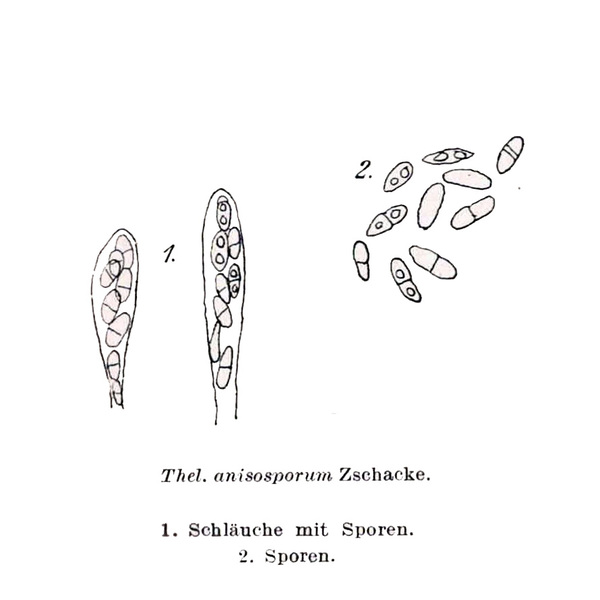Thelidium anisosporum (Müll. Arg.) Zschacke
Hedwigia, 62: 104, 1921.. Basionym: Sagedia anisospora Müll. Arg. - Flora (Regensburg), 57: 536, 1874.
Synonyms: Verrucaria anisospora (Müll. Arg.) Stizenb.
Distribution:
Description: Thallus crustose, thinly episubstratic, rusty red, continuous. Perithecia black, globose or subglobose, 0.3-0.5 mm across (in section), immersed in the thallus and in pits in the rock at the base, visible only for the punctiform, black, flattened ostiolar region. Involucrellum absent; exciple thin, brown, thicker and darker around the ostiole; hamathecium of periphyses and periphysoids, interascal filaments absent; hymenial gel I-. Asci 8-spored, narrowly ellipsoid, I-, fissitunicate, the wall slightly thickened above, 65-80 x 13-15 µm. Ascospores 1-septate, sometimes slightly constricted at septum, hyaline, narrowly ellipsoid, 12-18 x 4-8 μm. Photobiont chlorococcoid. Spot tests: K-, C-, KC-, P-, UV-. Chemistry: without lichen substances.Note: on gneiss in the subalpine to lower alpine belts; only recorded from the Western Alps (Switzerland); to be looked for in the Italian Alps.
Growth form: Crustose
Substrata: rocks
Photobiont: green algae other than Trentepohlia
Reproductive strategy: mainly sexual
Poorly known taxon in need of further study

Predictive model
Growth form: Crustose
Substrata: rocks
Photobiont: green algae other than Trentepohlia
Reproductive strategy: mainly sexual
Poorly known taxon in need of further study

Predictive model
 INDEX FUNGORUM
INDEX FUNGORUM
 GBIF
GBIF


